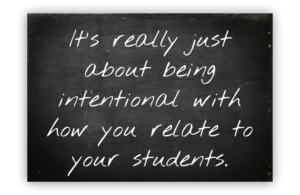
I was meeting with a high school ELA teacher last week who confided in me her lamentations about the unit she was teaching at the time. Literary Analysis. You can readily imagine the situation. She dreads the unit every year. It’s boring for students, uninteresting to grade, and generally considered one of the driest tasks of the year. When her students ask her why they have to do it, she tells them because that’s the kind of thing they will have to do (a lot!) in college. We are all familiar with the motivation and engagement that is likely to follow.
My goal with this post is to assure you that even if everything about the assignment remained the same, both teacher and students need not suffer quite so much through those kinds of dry and static learning experiences. (It so happens that I also have some suggestions that might add some vitality to the task itself, but that is not my goal presently.)
It’s a motivation problem
If you have been following our recent work, either here or on our podcast, then you are aware that in recent months, certain incredible ideas expressed by certain outstanding educators on the topic of motivation have been game-changing to us, to such a degree that it is my personal opinion that all (let’s assume there are always anomalies) behavioral problems that arise in the classroom setting can be addressed under one single umbrella. I am not going to dive deep into the whole thing, but you really should read Dave Stuart, Jr.’s These 6 Things. His work is what will motivate my discourse in this post.
Thus, I make my claim: in all things resembling the literary analysis situation, the problem is not an interesting activity problem. It is a motivation problem. Students, as Dave intimates, are generally willing to go to incredible lengths (even to enjoy otherwise mundane and boring tasks) when they believe certain key things about themselves and their teachers.
3 things that will move the needle
When we spoke with Dave, he clearly confirmed that the most important thing a teacher does to walk students down the path of motivation and engagement is to establish credibility. To get practical, let me offer three things that you can do immediately to help establish that credibility.
#1: Do daily/weekly morning meetings
Start every day/hour (or week, if that’s too much) with a sincere conversation about what’s going on in students’ lives and how that might be preventing or elevating their learning that day.
This is not “okay, let’s do ‘Good Things’ … because our school told us that’s a good thing and we can spare a couple minutes to just chat anyway.” Students (of any age) see through initiatives that teachers are implementing because those are the initiatives teachers are told to implement. This conversation must be real, and it must be important to YOU.
Tell your students that you know stuff is going on in their lives that makes learning tough, and you want them to know that you care about them and that stuff and helping them get through it so that all of you can accomplish as much as possible that day.
And be prepared to share your own stuff. They won’t see you as human until they see your warts. Be mindful of the work/home balance and boundaries, but let your humanity show, as well.
#2: Ask your students questions about themselves
If you are implementing #1 well, then you will have tons of things to ask students over time. Learn what your students like and do and ask about that stuff. Dave has a great idea for this kind of thing that he calls moments of genuine connection. It’s really just about being intentional with how you relate to your students. It can be during class, in the hall, before/after school.
#3: Stop accusing and start inquiring
Have you ever watched a students’ face when he/she walks into class late and flustered and the teacher says, “You’re late. Have a seat.” It seems insignificant. But you and I both know that the student who hears that immediately forms an opinion about just how much that teacher cares about him/her.
The alternative is simply to acknowledge the student (a nod and smile if it’s too much disruption to talk then) and ask about why that happened. Ask sincerely. Seek to understand.
The same perspective applies to nearly everything: phone going off in class, late project, incomplete work, disruptions in class. There is not always a compelling circumstance behind these things, but by seeking one instead of assuming otherwise, you will only ever grow your credibility in your students’ eyes.
In short, relationship first
Education is an interpersonal profession. Relationship, therefore, is the catalyst to every reaction, academic, behavioral, or otherwise. Focus on that, and so many of the other concerns will dissolve. And while you are thinking about it, check out Dave Stuart, Jr.’s work.


